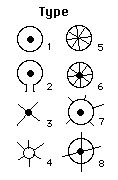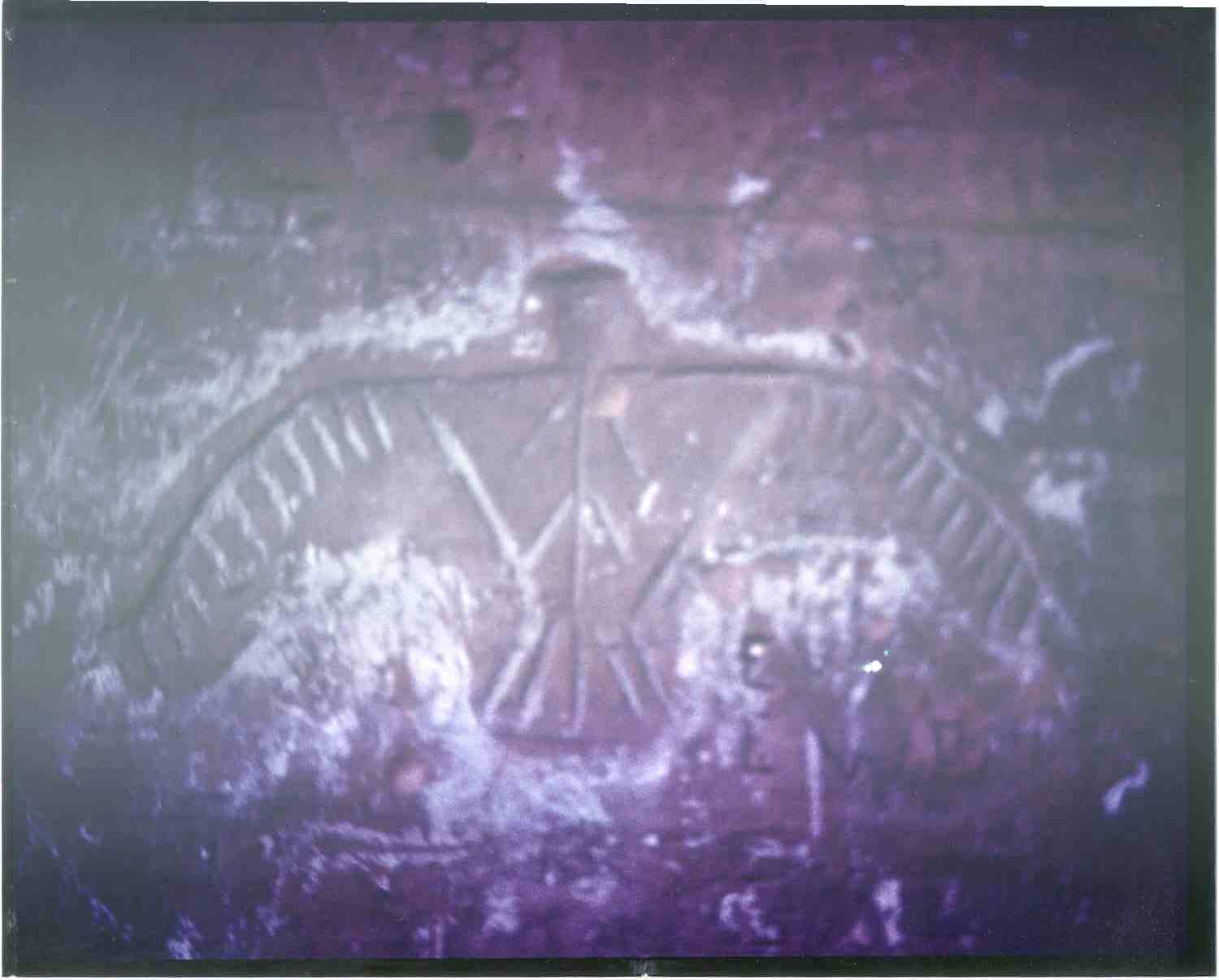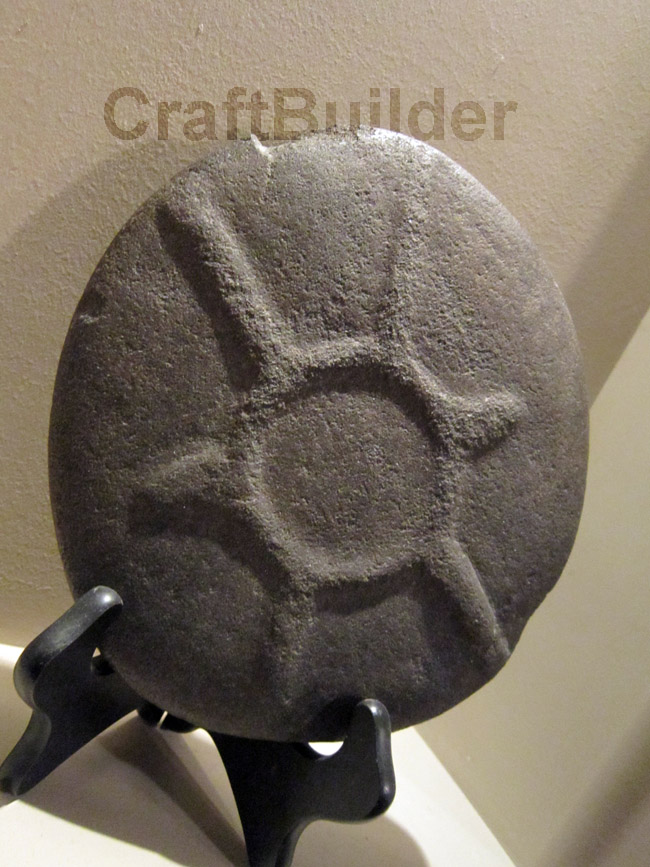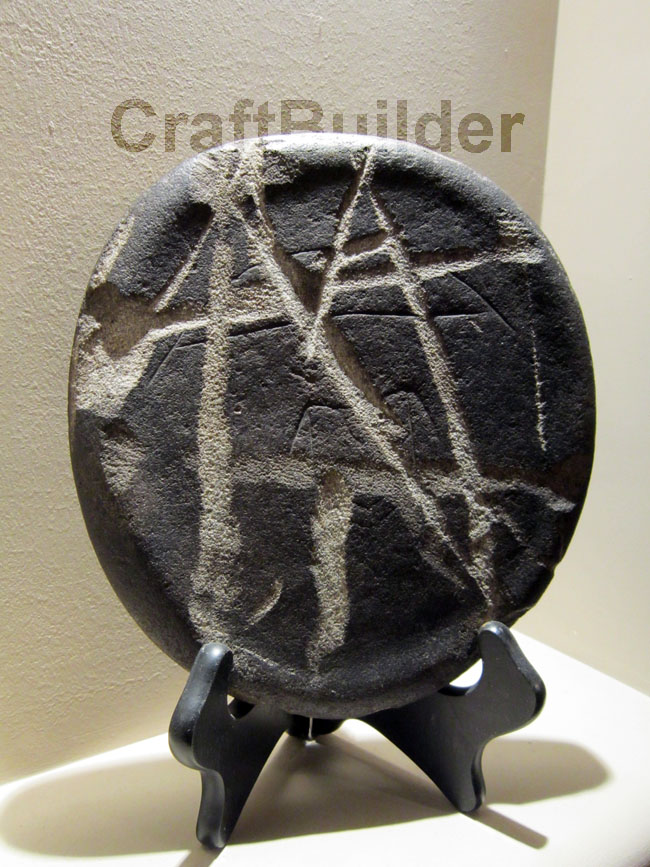It looks like you're using an Ad Blocker.
Please white-list or disable AboveTopSecret.com in your ad-blocking tool.
Thank you.
Some features of ATS will be disabled while you continue to use an ad-blocker.
share:
The sun symbol is common across the Americas but I've never seen a grinding stone with decorations and I've seen a ton of them. Here's why---the
decoration would get in the way of the work. In using the stone the decorations would be worn away rather quickly.
The closest thing I can think of (from only viewing a pic) is a "gaming stone." In the Mississippian culture the game was called "Chunky Stones" and was played by rolling these specially prepared stones and throwing a spear to mark where the stone would stop rolling.
Wiki has a fairly good description of the stones and game. en.wikipedia.org...
The best depictions of these players come from shell gorgets found at the sites and from early European accounts of the games they observed.
The size of your stone is within the sizes I've seen in Middle Mississippian sites. I've never seen one with decorations but then, I've not studied that time period in Canada very closely.
I hope I'm not too late with this request---please don't use anything but water and a soft brush, like a toothbrush, to clean it. Some of these objects have been shown to have had a thin covering of copper foil, especially some of the ones found in the Upper Mississippi Valley sites, where copper was more common. It would probably take looking at the surface with a good magnifying glass to see the fragments of the green of copper patina. Some were highly burnished black stone. The manufacture of these stones is still one of the little-spoken-of mysteries of this culture. I've known of more than half a dozen experimental archaeology classes that have tried to reproduce one and failed.
These stones took an amazing amount of man-hours of work and were understandably passed from generation to generation so it's not really surprising that the incising on one side could have been done by a different craftsman to "update" the stone. We see this fairly often with signs that artifacts have been "remodeled" over time.
Is there a university with a geology or earth sciences department near you? They could probably identify the type of stone for you and point you to an archaeologist who works in your area. Notice that I say "who works in your area" because many, many archaeologists in local universities have no knowledge of the local prehistory.
As far as ownership, I'd check the laws of Canada. In the US if the artifact is found on private property it is owned by the landowner. However, if the landowner allows an academic excavation on his property, he must sign an agreement that allows the university to hold the recovered artifacts for an agreed period of time to allow for analysis.
Hope this helps....just google for images of Chunky stones and/or Chunky Stones and Cahokia---there was a nice cache found there.
The closest thing I can think of (from only viewing a pic) is a "gaming stone." In the Mississippian culture the game was called "Chunky Stones" and was played by rolling these specially prepared stones and throwing a spear to mark where the stone would stop rolling.
Wiki has a fairly good description of the stones and game. en.wikipedia.org...
The best depictions of these players come from shell gorgets found at the sites and from early European accounts of the games they observed.
The size of your stone is within the sizes I've seen in Middle Mississippian sites. I've never seen one with decorations but then, I've not studied that time period in Canada very closely.
I hope I'm not too late with this request---please don't use anything but water and a soft brush, like a toothbrush, to clean it. Some of these objects have been shown to have had a thin covering of copper foil, especially some of the ones found in the Upper Mississippi Valley sites, where copper was more common. It would probably take looking at the surface with a good magnifying glass to see the fragments of the green of copper patina. Some were highly burnished black stone. The manufacture of these stones is still one of the little-spoken-of mysteries of this culture. I've known of more than half a dozen experimental archaeology classes that have tried to reproduce one and failed.
These stones took an amazing amount of man-hours of work and were understandably passed from generation to generation so it's not really surprising that the incising on one side could have been done by a different craftsman to "update" the stone. We see this fairly often with signs that artifacts have been "remodeled" over time.
Is there a university with a geology or earth sciences department near you? They could probably identify the type of stone for you and point you to an archaeologist who works in your area. Notice that I say "who works in your area" because many, many archaeologists in local universities have no knowledge of the local prehistory.
As far as ownership, I'd check the laws of Canada. In the US if the artifact is found on private property it is owned by the landowner. However, if the landowner allows an academic excavation on his property, he must sign an agreement that allows the university to hold the recovered artifacts for an agreed period of time to allow for analysis.
Hope this helps....just google for images of Chunky stones and/or Chunky Stones and Cahokia---there was a nice cache found there.
edit on
11-1-2014 by diggindirt because: clarity
reply to post by CraftBuilder
The second photo looks like the characters from the Kensington RuneStone.
The second photo looks like the characters from the Kensington RuneStone.
Xcathdra
reply to post by CraftBuilder
The second photo looks like the characters from the Kensington RuneStone.
I thought so too at first but the prominent marks are from a plow. Slightly fainter there is a petroglyph of what appears to be a bird though its hard to say for sure because there are pieces missing from being scraped off by the plow.
TheLieWeLive
I'm guessing it was used to grind corn in to corn meal. The side that looks like the sun is probably the bottom that sits on the ground while the other side has a lip that helps keep the corn meal from spilling out.
My guess for whatever that's worth.
It isn't a mocajete. I use one very frequently, and even the rough texture of the stone can be a pain because it collects little bits of your stuff you are grinding. Having those grooves from the glyph would be problematic.
However, it could be possible that a shaman would use a mocajete with a glyph in it when preparing remedy. Imbue the magic of the glyph into the herbal mixture being pulverized.
A mocajete will usually be like a bowl, so you can prepare food with it and not have it all over the ground. If the herbal remedy were a small one, I could see that functionality with this stone. But it is a long shot, IMO, based on my experience using such a piece of stone.
I would certainly stop plowing the area and maybe call a school to do a dig/investigate the area.
Kangaruex4Ewe
I didn't notice that before. It almost looks like a pterodactyl.
ezekielken
reply to post by bigfatfurrytexan
I think the top of this plate took the damage unfortunately. If you look under the obvious new striations it appears to me that there is a glyph.
I agree. In "Paint" 'Invert colors' - then a few hits on the 'Auto Correct' function in 'Microsoft Office Picture Manager' brings it out a little more..............

edit on 11-1-2014 by ExoPatriotico because: (no reason given)
It looks like the Giza Pyramid star alignment.
It also looks like the map from Betty and Barney's hills ordeal back in the day. Out of curiosity have you been rotating the item when making comparisons?
It also looks like the map from Betty and Barney's hills ordeal back in the day. Out of curiosity have you been rotating the item when making comparisons?
reply to post by Xcathdra
The SCARS are covering the glyph - they are not indicators of any kind of an alignment - they are plow marks. Look at the drawing under the scars.
The SCARS are covering the glyph - they are not indicators of any kind of an alignment - they are plow marks. Look at the drawing under the scars.
edit on 11-1-2014 by ExoPatriotico because: (no reason given)
CraftBuilder
Please help identify the culture responsible for this object and it’s age.
An acquaintance of mine found this stone in an agricultural field in Alberta, Canada
It is a relief style carving from what appears to be local field stone (not verified). It is about the size of a dinner plate. The smallest diameter is about 20.3 cm and the largest diameter is about 21.6cm. It is about 2.5cm thick. The relief stands out about 3-4mm and the outside diameter of the circle in the depiction is about 8cm.
The back of the artifact is deeply scarred from modern agricultural machinery, however there is also a carving visible on the back from a completely different method used on the front. It is the more typical thin line scraped carving seen in very old petroglyphs. I’m hoping somebody recognizes this symbol.
The stone is much darker than it appears in the images. Where it has been recently chipped it is a very uniform single shade of black and is very granite like.
So much careful work was put into this artifact that I believe it had considerable importance. Artifacts like this are not common for the area and I don't know if it might be completely unique. We see a lot of tools (arrow heads, hammer stones) but not elaborate stone artwork like this.
gave me chills looking at that 2nd pic.
It is almost identical to my right palm print
reply to post by bigfatfurrytexan
Can you give an approximate location within Alberta that this was removed? Thanks...
Can you give an approximate location within Alberta that this was removed? Thanks...
reply to post by BuzzDengue
reply to post by MinorityReporter
At this point I do not know what part of Alberta the artifact was found in. My acquaintance understandably is not keen on drawing a lot of attention to themselves or to the location of the find. I have every intention of honoring that choice. I have posted this topic on their behalf (with their permission) in order protect their privacy but also because I know that others here would be as interested in the artifact as I am. My acquaintance has not offered the location of the find and I have not asked.
If they become comfortable with defining a more specific part of Alberta I will post it the moment that I have their permission. I do know that my acquaintance is the one who originally discovered the artifact, so the exact location of its origin can be determined.
reply to post by MinorityReporter
At this point I do not know what part of Alberta the artifact was found in. My acquaintance understandably is not keen on drawing a lot of attention to themselves or to the location of the find. I have every intention of honoring that choice. I have posted this topic on their behalf (with their permission) in order protect their privacy but also because I know that others here would be as interested in the artifact as I am. My acquaintance has not offered the location of the find and I have not asked.
If they become comfortable with defining a more specific part of Alberta I will post it the moment that I have their permission. I do know that my acquaintance is the one who originally discovered the artifact, so the exact location of its origin can be determined.
I’m thinking a Medicine Wheel also. Type 4

Links:
www.royalalbertamuseum.ca...
www.crystalinks.com...
What a cool find. Lucky Lucky

Links:
www.royalalbertamuseum.ca...
www.crystalinks.com...
What a cool find. Lucky Lucky
reply to post by SeekingDepth
The #4 pattern is similar. The article says that medicine wheels were a large pattern of rocks laid out on the ground, some up to 75 feet in diameter. Have you come across any examples of these patterns being carved into stones?
The #4 pattern is similar. The article says that medicine wheels were a large pattern of rocks laid out on the ground, some up to 75 feet in diameter. Have you come across any examples of these patterns being carved into stones?
The side of the artifact, scarred by a plow, appears to me, to be very similar to glyphs representing possibly these ancient Anishinaabe people
associated with Canada.

en.wikipedia.org...
Nice find by your friend...
Des

en.wikipedia.org...
Nice find by your friend...
Des
reply to post by CraftBuilder
No not yet still looking. There are a lot of the ones laid out on the ground in patterns in Alberta so just guessing.

www.virtualsk.com...
No not yet still looking. There are a lot of the ones laid out on the ground in patterns in Alberta so just guessing.

www.virtualsk.com...
reply to post by CraftBuilder
My guess is that it was something to do with the Native American 'Sundance' ritual.
No proof, it just looks like a Sun.
My guess is that it was something to do with the Native American 'Sundance' ritual.
No proof, it just looks like a Sun.
My acquaintance thinks it looks like a turtle so I've been researching along those lines. The shape of the depiction is similar to several turtle
glyphs but I have not been able to find anything remotely similar carved as a relief like this one is.
The Western Painted Turtle is native to Alberta and could have served as inspiration for such a carving.
The Western Painted Turtle is native to Alberta and could have served as inspiration for such a carving.
reply to post by CraftBuilder
wow what an amazing find!!!!
If you look at the back side carving, it almost looks like a ufo is carved into it and under that it looks like (now I could be wrong) a carving I have seen In a book I read awhile ago. The carving that it reminds me of is that of a helmet. I will hunt for that picture and post it as soon as I find it. The weird thing about it is I remember hearing that that carving was from Africa or South America...... I will keep you posted with my findings. Thanks for the great Thread!!!!!!!!!!!
wow what an amazing find!!!!
If you look at the back side carving, it almost looks like a ufo is carved into it and under that it looks like (now I could be wrong) a carving I have seen In a book I read awhile ago. The carving that it reminds me of is that of a helmet. I will hunt for that picture and post it as soon as I find it. The weird thing about it is I remember hearing that that carving was from Africa or South America...... I will keep you posted with my findings. Thanks for the great Thread!!!!!!!!!!!
new topics
-
How To Spot Fake U.F.O. Photos
Aliens and UFOs: 2 hours ago -
Scary video of face in an abandoned house
Paranormal Studies: 4 hours ago -
Just Came Across These Unusual Old UFO Pics
Aliens and UFOs: 6 hours ago -
LA Mayor Bass Demanded $49M in Additional LAFD Cuts One Week Before Wildfires
Mainstream News: 8 hours ago -
Sepultura - Territory - With New Drummer Greyson Nekrutman
Music: 9 hours ago -
Carry On!
Short Stories: 9 hours ago
top topics
-
This should be plastered all over the airwaves
Mainstream News: 15 hours ago, 24 flags -
LA Mayor Bass Demanded $49M in Additional LAFD Cuts One Week Before Wildfires
Mainstream News: 8 hours ago, 17 flags -
Archbisop Vigano Warns of Deep State and Deep Church
New World Order: 17 hours ago, 16 flags -
Oh, Good Gosh. “Kremlin Warns Stay Away from Greenland.”
World War Three: 17 hours ago, 12 flags -
Just Came Across These Unusual Old UFO Pics
Aliens and UFOs: 6 hours ago, 7 flags -
Scary video of face in an abandoned house
Paranormal Studies: 4 hours ago, 5 flags -
How To Spot Fake U.F.O. Photos
Aliens and UFOs: 2 hours ago, 4 flags -
Carry On!
Short Stories: 9 hours ago, 3 flags -
Sepultura - Territory - With New Drummer Greyson Nekrutman
Music: 9 hours ago, 2 flags
active topics
-
Old School Punk
Music • 566 • : underpass61 -
-@TH3WH17ERABB17- -Q- ---TIME TO SHOW THE WORLD--- -Part- --44--
Dissecting Disinformation • 3987 • : duncanagain -
To become president, Zelensky had to learn Ukrainian
Political Conspiracies • 44 • : SteamyAmerican -
Los Angeles brush fires latest: 2 blazes threaten structures, prompt evacuations
Mainstream News • 383 • : WeMustCare -
Judge rules president-elect Donald Trump must be sentenced in 'hush money' trial
US Political Madness • 120 • : Vermilion -
This should be plastered all over the airwaves
Mainstream News • 55 • : Astrocometus -
Oh, Good Gosh. “Kremlin Warns Stay Away from Greenland.”
World War Three • 32 • : SteamyAmerican -
Candidate TRUMP Now Has Crazy Judge JUAN MERCHAN After Him - The Stormy Daniels Hush-Money Case.
Political Conspiracies • 2190 • : WeMustCare -
Iran Sympathizers in Biden Admin Leak Intelligence on Israel Attack Plans
Mainstream News • 86 • : WeMustCare -
How To Spot Fake U.F.O. Photos
Aliens and UFOs • 1 • : nugget1


